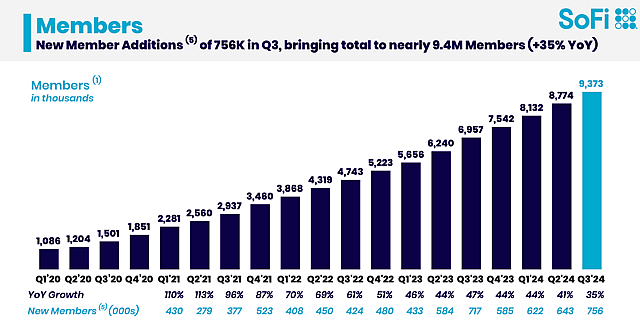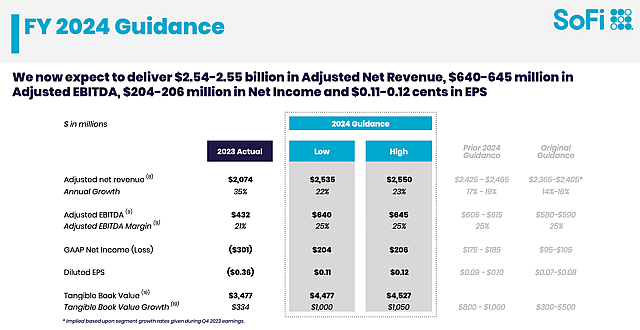Last Update 04 Nov 25
SoFi Stock: Explosive Growth, Real Profits
SoFi Technologies (NASDAQ: SOFI) delivered another record-breaking quarter, showing it is no longer just a fintech disruptor — it is a fully scaled digital financial institution. For Q3 2025, the company posted record GAAP net revenue of $962 million, up 38% year-over-year, and adjusted net revenue of $950 million. Net income reached $139 million, marking its eighth consecutive quarter of profitability, while adjusted EBITDA rose 49% to $277 million.
Membership continues to soar. SoFi added 905,000 new members this quarter — a record — bringing total members to 12.6 million, up 35% year-over-year. Total products reached 18.6 million, up 36%, with 40% of new products coming from existing customers — a sign its “one-stop financial ecosystem” strategy is working.
The Flywheel Is Spinning: Lending + Fee-Based Revenue
SoFi’s business model has evolved beyond lending. While lending remains the largest revenue driver, the real shift is happening in services and technology:
✔ Fee-based revenue hit a record $409 million — up 50% year-over-year. ✔ Combined Financial Services + Technology revenue hit $534.2 million, up 57% from last year. ✔ Loan Platform Business (LPB) originated $3.4 billion in loans on behalf of third parties, generating $168 millionin revenue — a 2.75× increase year-over-year.
Still, lending remains a powerhouse. Total originations hit $9.9 billion, up 57% YoY — including $7.5B personal loans, $1.5B student loans, and ~$945M home loans. Personal loan net charge-offs also fell to their lowest level in over two years, with credit performance improving across the board.
Expert Insight: Strong Model, But Interest Rate Risk Is Real
According to Kevin Marshall, CPA at Amortization Calculator, SoFi’s financial engine is increasingly comparable to a bank — not a fintech startup. He notes that the company’s biggest strength is its ability to monetize members repeatedly across lending, investing, cash management, and financial services, while maintaining low customer acquisition costs.
But he also highlights a structural concern: SoFi’s profitability still relies heavily on rate spreads and loan origination volume. If interest rates fall sharply or credit demand slows, SoFi’s lending margins could compress, while deposit costs remain sticky. Additionally, as SoFi builds more banking infrastructure (compliance, reserves, regulatory stress testing), operating costs will naturally rise.
In Marshall’s view, the key question is whether fee-based revenue and technology licensing can eventually outweigh interest-rate sensitivity — a transition critical to unlocking long-term investor upside.
Innovation: AI, Blockchain, and Financial Automation
SoFi is rapidly expanding into AI and blockchain-enabled services:
- AI-powered Cash Coach helps members automate budgeting and saving.
- SoFi Pay uses blockchain to power near-instant, low-cost international transfers.
- SoFi Crypto launches later this year, allowing users to buy and hold digital assets directly in the app.
- New features like Level 1 options, alternative investing, and interest-only personal loan structures keep product velocity high.
Brand awareness is also booming. Unaided awareness is now 9.1%, up fourfold in four years, supported by heavy marketing and partnerships (stadium naming, influencer campaigns, etc.).
Balance Sheet and Guidance Strengthen the Bull Case
- Adjusted EBITDA margin: 29%
- Net income: $139M (GAAP) — profitable for 8 straight quarters
- Raised full-year 2025 guidance due to strong member growth and loan performance
- Credit risk remains stable: 90-day delinquencies up just 1 basis point
SoFi also maintains strong liquidity and is positioned to expand deposit funding further — a cheaper alternative to borrowing in credit markets.
SoFi Technologies (SOFI) continues to ride the waves in the financial world, propelled by robust membership growth, product adoption, and diversification across its ecosystem.
In Q3 2024, the company declared a massive stock price increase over the past month, propelled by investors’ strong confidence in the company’s performance and general potential for further growth.
SoFi’s Membership Surge and Diversified Growth Fuel Upgraded Outlook
Membership growth remains a cornerstone of SoFi’s success. From Q1 2021 to Q3 2024, membership grew 75.81%, further supported by strong marketing and an ever-expanding suite of financial services. In Q3 2024 alone, SoFi added 756,000 new members, continuing its substantial quarterly gains. In concert with this, product adoption outpaces membership growth, a sign of increased engagement inside its FSPL or Financial Services Productivity Loop.
This has been supplemented by cross-selling services, including SoFi Money, SoFi Invest, and SoFi Relay, which has grown revenue per member while further diversifying the revenue base.

Net interest margin (NIM) has been one of the leading factors for SoFi’s profitability. Although NIM increased to 5.57% in Q3 2024 from 4.38% in Q1 2022, it has faced some headwinds lately, falling from its peak of 6.02% in Q4 2023. Such a trend would indicate pressure on interest income if interest rates continue lowering further. Despite this, SoFi has used its ecosystem pretty well to drive non-interest income and eliminate part of the risks of volatile margins.
SoFi’s expansion into non-lending products has indeed paid dividends. They saw considerable increases in product numbers for Money and Invest, where the number of users for SoFi Money surged by 54.05% YoY, and Relay users grew by 41.99% YoY at the end of Q3 2024. This diversification has made it less dependent on lending revenues, positioning the company as resilient when economic conditions change.
Sofi upped its annual revenue growth guidance 2024 to 22%-23% YoY from an initial projection of 14%-16%. This upward revision reflects confidence in maintaining growth in lending and non-lending segments. Financial services products to the number of lending products went up two-fold from 3.1x in 2021 to 6.2x in 2024, demonstrating the efforts toward a more balanced and diversified revenue model.

SoFi’s Growth Faces Margin and Market Challenges Ahead
SoFi’s impressive growth trajectory faces several potential risks that could impact its long-term outlook. Interest Margin Pressure One of the most important risks is that SoFi attains most of its profitability from NIM. If the Federal Reserve loosens further, it may see off significantly from SoFi’s net interest income. In Q3 2024, NIM compressed further to 5.57% from the Q4 peak of 6.02%. If the margin pressures persist, it could erode profitability, especially within the highly competitive fintech landscape.
The fintech space is highly competitive, where conservative financial institutions and lean startups fight for market share. SoFi’s ability to gain and retain customers while remaining competitive will be of the essence. Moreover, regulatory risks are high. Regulation changes concerning lending or consumer protection laws might raise compliance costs or dampen revenue opportunities.
According to digital finance expert Jason Wise, SoFi’s growth heavily relies on cross-selling its ecosystem of products. This strategy has been fruitful so far but could be subject to decreasing returns as the customer base expands. When the market is saturated or the effectiveness of cross-selling diminishes, it will eventually impact customer lifetime value and overall growth rates. Of course, broader economic challenges pose risks: A potential economic downturn could lead to reduced consumer spending, higher loan defaults, and lower demand for investment products.
Lastly, SoFi derives revenues from various sources, including newer non-lending products such as SoFi Money and SoFi Invest. This further complicates matters as these nascent offerings face intense competition with any associated margin pressures. In sum, while SoFi’s long-term potential remains sound, it must work through these risks to continue on this growth trajectory and create value for shareholders.
Takeaway
The bottom line is that SoFi’s recent performance underlines its continuing ability to produce sustained growth via innovation, diversification, and ecosystem expansion. At the same time, however, investors should look for possible short-term pullbacks with the stock now in overbought territory, compliments of recent strong performance and technical caution indications.
Have other thoughts on SoFi Technologies?
Create your own narrative on this stock, and estimate its Fair Value using our Valuator tool.
Create NarrativeHow well do narratives help inform your perspective?
Disclaimer
The user yiannisz has a position in NasdaqGS:SOFI. Simply Wall St has no position in any of the companies mentioned. Simply Wall St may provide the securities issuer or related entities with website advertising services for a fee, on an arm's length basis. These relationships have no impact on the way we conduct our business, the content we host, or how our content is served to users. The author of this narrative is not affiliated with, nor authorised by Simply Wall St as a sub-authorised representative. This narrative is general in nature and explores scenarios and estimates created by the author. The narrative does not reflect the opinions of Simply Wall St, and the views expressed are the opinion of the author alone, acting on their own behalf. These scenarios are not indicative of the company's future performance and are exploratory in the ideas they cover. The fair value estimates are estimations only, and does not constitute a recommendation to buy or sell any stock, and they do not take account of your objectives, or your financial situation. Note that the author's analysis may not factor in the latest price-sensitive company announcements or qualitative material.




